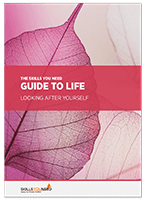The Science of Mindfulness –
3 Ways to Get the Benefits of Meditation
See also: What is Mindfulness?
If there’s one thing that’s been scientifically proven to improve the quality of your life, it’s mindfulness.
Research has shown that mindfulness:
- Reduces stress.
- Can treat anxiety and depression as effectively as antidepressants.
- Improves willpower.
- Increases the density of the gray matter in your brain.
That's right, mindfulness doesn’t just improve your subjective well-being, it physically changes the part of your brain that’s associated with stress-reduction, too.
What Is Mindfulness, Really?
Is mindfulness something you get when you live in a cave and contemplate the nature of existence? Is it something you find by meeting a spiritual guru at the top of a lonely mountain? Not necessarily.
Mindfulness is the feeling you get when you get lost in someone’s eyes (or lost in a pint of Cherry Garcia ice cream), and you become totally absorbed in the sensory experience.
We spend most of our time thinking about the past or the future, but mindfulness is a state of immersion in the present moment.
The human brain is designed to constantly judge. Thoughts run through our mind like:
- "Why do I feel so tired?"
- "What can I do to get rid of this stress I’m feeling
- Why did I eat a whole pint of Cherry Garcia in one sitting?
Mindfulness is a state in which your consciousness no longer spends energy on judging, this frees it to focus completely on experiencing.
Mindfulness is powerful. For many of us, our best memories are moments in which we experienced a high degree of mindfulness.
Anyone can train their mind to become mindful. But our attempts to do so are often doomed from the start because of two pervasive cultural myths about mindfulness.
Myth 1: Mindfulness Is Religious

Mindfulness is strongly associated with eastern spiritual traditions. When we think of mindfulness, we think of Chakra alignment and monks who’ve given up all their physical possessions. And yes, mindfulness can be tied to a religious practice, but it by no means needs to be.
Meditation is the most well-known method for bringing more mindfulness into your life. Meditation isn’t religious, it is simply a method of training the mind, similar to how exercise trains the body.
Mindfulness meditation is the practice of becoming aware of your thoughts and feelings. The more you meditate, the more often you’ll be able to access a state of mindfulness (even if you don’t give up all your possessions and join a monastery).
Myth 2: Mindfulness Is Emptying Your Mind of Thought
The most widespread myth about mindfulness is also the most problematic. Mindfulness is often thought of as a way to control your thoughts.
Mindfulness isn’t about turning off the voice in your head; that would be an impossible task. In fact, trying to control the mind only agitates it to become more hyperactive.

You know those Chinese finger traps where you put each of your index fingers in one side? The harder you try to pull your fingers away from each other, the tighter the trap grips you. That’s what trying to control your thoughts is like.
Chinese finger traps have a counterintuitive solution. Instead of pulling your fingers away from each other, you push them towards each other, and the trap loosens its grip. That’s what mindfulness is like. It’s not about fighting against your thoughts, it’s about learning to accept them as they are. You can’t force mindfulness by trying to control your thoughts, you ease into it gently by becoming aware of your thoughts.
Many people try meditation once and give up because it’s frustrating that they cannot turn off their mind for more than a couple seconds.
But the goal of meditation isn’t to clear the mind - and trying to clear the mind has the opposite of the intended effect.
If you were to lift weights once, you wouldn’t expect to look like Thor by the end of an hour session. Similarly, there’s no reason to be frustrated if practicing mindfulness doesn’t empty your mind of all thought. That isn’t the goal of mindfulness in the first place.
The Benefits of Meditation in a World Addicted to Distraction

In the modern world, our minds are trained by technology to be in a constant state of distraction. Now, more than ever, taking steps to build mindfulness has tremendous benefits.
The philosophy underpinning this culture of distraction is that the world around us is uninteresting and, to feel good, we must find something more engaging to do (like refresh Instagram every 30 seconds).
The philosophy underpinning mindfulness is the opposite: the world around is a feast for the senses waiting to be enjoyed and, by learning to give up the desire to be somewhere else, we can fully immerse ourselves in the present moment.
How to Get the Benefits of Meditation in Your Life
So, mindfulness can significantly improve the quality of our lives, but how do we actually get more of it? Dedicated practice.
Now, meditation is one route to mindfulness, but it’s not the only option. There are three methods for practicing mindfulness that are particularly effective.
1. Mindful Walking
Mindful walking is a method that brings meditative practice into the outside world. Instead of sitting in a quiet room, you’re exploring nature.
Mindful walking allows you to kill two birds with one stone. Not only will you gain the stress-reduction benefits of meditation, but walking can also be a surprisingly effective form of exercise for improving your health and losing weight.
For a walk to be a mindfulness practice, your intention should be to notice both your thoughts and the world around you. As you walk, make a point to take in the scents, to feel the breeze on your skin (or if like me, you live in Arizona, feel the sun burning your skin). Really take in the sights, the sounds, and the feelings you experience.
Most importantly, notice when you get distracted. As thoughts run through your mind about what you have to do later, or you start judging your experience (i.e. “It’s too hot” or, “When did I become a hippie who goes on mindful walks?”) simply notice those thoughts. The goal isn’t to eliminate your thoughts, it’s just to be conscious of them. The part of your mind that you access when you notice your own thinking, that’s mindfulness. By tuning into that part of your mind during your walk, you are strengthening your ability to gain the benefits of meditation not only while on your walk, but throughout the day. (PS: It’s best practice to leave your phone at home, or at the very least, to turn off notifications and keep it in your pocket during your mindful walk.)
2. Yoga

In the west, yoga is mostly seen as a type of exercise, but it’s also a great method for practicing mindfulness. While doing Yoga, you can focus on the sensations in your body as well as the thoughts going through your mind.
During yoga, you can expect to feel a small amount of physical discomfort as you stretch your body past its usual limits. This discomfort is an opportunity for training not just your body, but your mind as well. Don’t avoid the pain, let it in, accept it as it is — doing so will help you bring mindfulness into your daily life.
Although yoga is the form of exercise most associated with mindfulness, you can turn any type of solo exercise into a meditative experience.
Whether you’re weightlifting, running, biking, or shooting free-throws, you can practice bringing your awareness to the details of what you’re doing: the feeling of your legs hitting the pavement, the tension in your arms as you push a heavy weight, or the sight of a basketball moving through the air (and if you’re like me, seeing the ball miss the basket by about two feet).
For exercise to be a form of dedicated mindfulness training, it’s best done alone because interacting with other people will make it difficult to focus on your mental practice.
3. Meditation

There are numerous types of meditation you can practice. Here, we’re going to focus on mindfulness meditation, which is what most psychological research has focused on.
To start, sit down with your back straight. It’s best to avoid laying down because that can turn your meditation into more of a nap (I speak from experience). You don’t have to sit on the floor, you can sit on a chair, against a couch, or however you prefer.
When you’re first starting, I recommend keeping your practice sessions relatively short (from 5–15 minutes). It’ll be easier to build momentum and maintain meditation as long-term habit that way.
While sitting, simply observe your breath. You can focus on the air moving through your nose and mouth. You can notice the expansion of your lungs. Or you can pay attention to any of the other sensations you feel while breathing.
As you do this, you will undoubtedly start to drift off. Your mind will think about everything other than your breath. As this happens, don’t get frustrated or feel like you’re doing meditation wrong. Just acknowledge that you drifted off and bring your attention back to the breath.
You don’t have to try to stop your thoughts, simply make a point to notice when you get wrapped up in them. Remember, the part of your consciousness that notices when you get lost in thought, that’s mindfulness.
An alternative method for practicing mindfulness is to focus not just on your breath, but on any and all of your senses. Pay attention to the sounds in the room and outside, the sensations on your skin, etc. Try both methods and use whatever resonates most with you.
In a ten-minute meditation session, you can expect to get lost in thought dozens of times. That’s okay. Remember, expecting to be mindfully aware of your breath for several minutes straight is like expecting to bench press 300 pounds on your first trip to the gym.
Your meditation will build your mindfulness muscle. As the weeks and months go by, you will gradually gain the benefits of meditation not only during your practice, but throughout the day.
Guided Meditations
Guided meditations are useful for the same reason that taking music lessons is helpful. If you’re starting to learn the guitar, the difficulty of the initial learning period can be both frustrating and discouraging. A good teacher can point you in the right direction and help correct the mistakes you’re making.
With mindfulness, using guided meditation as a learning tool can help you feel confident that you’re “doing it right,” and it can accelerate your initial learning curve.
There are thousands of guided meditations you can find online through Google or YouTube. My personal favorites are the apps Calm and Headspace, both of which have a beginner series to show you the ropes of meditation. The websites Tarabrach.com and the UCLA Mindfulness Research Center also have high quality free guided meditations you can check out, you can also learn more about Yoga Nidra for meditation here on Skills You Need.
Further Reading from Skills You Need
The Skills You Need Guide to Life: Looking After Yourself
Based on some of our most popular content, this eBook will help you to live a happier, healthier and more productive life.
Learn how to look after your body and mind: the fundamental first steps to personal development.
This eBook, now in its second edition, with new and revised content, is designed to make life both easier and better.
Conclusion – 3 Ways to Get the Benefits of Meditation
Mindfulness may seem like a fad reserved for “granola crunchers”, yet scientific studies have provided extensive evidence for the benefits of meditative practices.
Furthermore, famed author of Tools of Titans, Tim Ferris has asked many of the world’s top performers (actors, businesspeople, athletes, and everything in between) about their habits. Tim Ferris noticed that one of the most common habits of highly successful people is some type of meditative practice.
Mindfulness allows us to escape the rat race and to truly experience the richness surrounding us in any given moment.
Most of us spend our time thinking of happiness as something we’ll earn when we reach a goal or get a promotion. Mindfulness is a different approach. Instead of trying to create happiness in the future, it’s about finding the happiness that’s available to us right now, in the present moment.
About the Author
Avery Hayden’s struggle with anxiety and panic disorder lead him to become deeply interested in psychology and self-improvement. He read hundreds of books about anxiety, stress, and finding happiness and found that true personal transformation is possible.
Continue to:
Top Tips to Reduce Stress
Mindful Meetings
See also:
Mindful Parenting | Relaxation Techniques
Laughter Yoga | Avoiding Burnout


